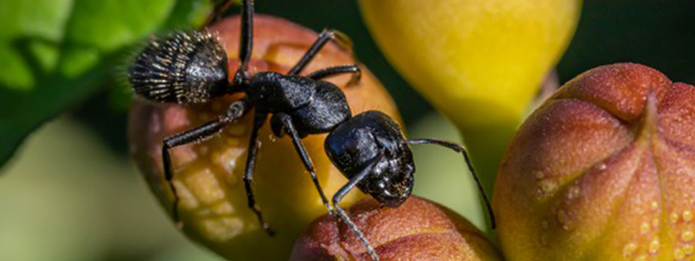Do Carpenter Ants Bite?

As insects go, carpenter ants seem to be relatively harmless. How much damage could a colony of these tiny critters really cause? Unlike the average ant that crashes your picnic, however, carpenter ants present serious risks to homeowners. Consider some key facts that may help you understand the negative impact carpenter ants can have on your home and what you can do about it.
Ant Bites
The idea of an army of insects marching through your home in search of someone or something to bite is a disturbing thought, indeed. Fortunately, this is not the case with carpenter ants. It is very uncommon for these little critters to bite humans. When this does happen, the guilty ant is usually acting to protect its nest after people have disturbed it in some way. On the other hand, the large size of carpenter ants can make their bites painful, however infrequent they may be. The bites of these insects are sometimes made worse when the ants release formic acid, a chemical they use to ward off unfriendly visitors. Ants do not spread diseases and their bites generally clear up quickly and leave no lasting injuries.
Damage to Property
While humans may not need to fear being bitten by carpenter ants, these insects pose a significant threat to peoples’ property. Carpenter ants prefer to create their nests in damp or rotting wood. This means that homeowners’ furniture, decks, siding, trim and many other structural materials may be compromised if ants choose them as nesting sites. The tunnels these critters dig can be unsightly, but more importantly, they can weaken the structural integrity of weight-bearing components throughout a house.
Identifying Carpenter Ants
It is not always easy to differentiate between carpenter ants and termites or other ant species. In terms of their appearance, carpenter ants are relatively large and are often black, red or brown. Though they can fly during some parts of their life cycle, carpenter ants differ from termites in the way the ants have a narrower waist and a pair of anterior wings that are longer than the posterior ones.
The easiest way to identify a carpenter ant colony, however, is based on behaviour. Namely, the presence of carpenter ants is marked by small holes in wooden materials. These holes will be smooth, clean and located near piles of wood bits.
Deterring Carpenter Ants
There are several ways to discourage carpenter ants from entering your home. First, minimize their access to food. Be sure to keep your kitchen clear of crumbs and to use tightly sealed food containers. Second, avoid providing ideal opportunities for nest building. It is best to keep stacks of wood well away from your home and to replace any wooden materials that are starting to rot. Finally, be sure to limit access to your home by ensuring windows, doors and other areas do not have gaps or holes around them.
Know When To Call the Experts
If carpenter ants have already settled into a spot inside or outside your home, it’s time to call for backup. These insects can reproduce rapidly and are difficult to get rid of. If you eliminate some but leave a few stragglers behind, the problem may resume within a short period of time.
When you suspect you have an infestation, your local Truly Nolen Canada is the team to call. Our skilled technicians offer carpenter ant control Niagara that is effective, efficient and thorough. We take the time to examine the full extent of the pest problem and then formulate an action plan to suit your specific situation. You can count on us to implement optimal pest control strategies that restore your peace of mind. Give us a call today to learn more.